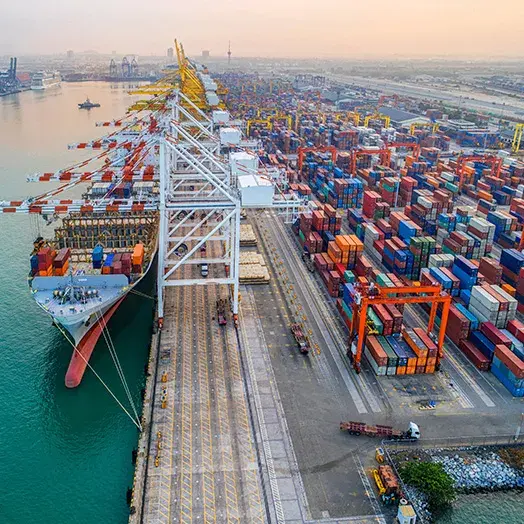Faculty members from the Johns Hopkins Carey Business School weigh in on how tariffs impact consumers and the overall U.S. economy.

Four experts explain how tariffs impact you
Tariffs, which are taxes imposed on imported goods, felt like something nobody talked about – that was until President Donald Trump took office earlier this year.
The President has committed to imposing tariffs, also known as import taxes, on foreign goods with the hope that Americans will produce and buy more domestic-made goods. On April 2, the White House declared that it would impose a 10% tariff on all countries, along with individualized higher tariffs on the countries with whom the U.S. has the largest trade deficits. The 10% baseline reciprocal tariffs include a 90-day negotiation period intended to give countries a chance to negotiate trade deals with the U.S. and avoid higher tariffs in the future.
As Trump’s strategy is well underway, a Reuters poll of economists this week showed that the majority think the global economy is at risk of slipping into recession this year due to the impact of U.S. tariffs. Since the beginning of the month, the tariffs on U.S. imports have wiped out trillions of dollars in stock market value and hurt investor confidence in U.S. assets, Reuters also reported. The poll showed that “None of the more than 300 economists polled said tariffs had a positive impact on business sentiment.”
There’s no doubt that the wide-scale tariffs will shake things up for businesses and consumers, and the general consensus is that prices will rise, with supply chain disruptions potentially leading to shortages of certain goods.
Faculty members at the Johns Hopkins Carey Business School share their insights on how Trump’s latest economic strategy could impact Americans’ everyday bills and purchases, as well as the global economy.
Consumer behavior and tariffs
Trump has said that tariffs could result in the U.S. eliminating income tax for people who make less than $200,000 a year; however, Andrew Ching, a marketing and economics professor at Carey who has researched consumer behavior in response to taxes, says that policymakers should account for the behavioral response of tariff opponents when predicting revenue.
"For consumers who oppose Trump, they may want to give less tariff revenue to the federal government,” Ching said. “As a result, they may reduce their demand more than Trump's supporters. Such responses would hurt import even more, and would lower the anticipated tariff revenue for the federal government."
What do tariffs do to the supply chain?
Carey Distinguished Professor Tinglong Dai argues in a Baltimore Sun opinion piece from earlier this year that tariffs have strained trade relations with Mexico, Canada, Japan, Germany, and South Korea and that tariffs can disrupt American supply chains, leading to unintended consequences. No single country, Dai adds, including the U.S., can manufacture everything it needs.
“Since the 1980s, globalization has led nations to specialize, creating supply chains that span continents,” Dai wrote. “Pressuring companies to manufacture in the U.S. may seem like a strategy for economic revitalization, but many industries lack the infrastructure, workforce, or favorable cost structure for large-scale relocating in the short term.”
Dai wrote on LinkedIn just this month that “tariffs shape all corners and all directions of global trade — and, with that, the U.S.’s standing as both a top importer and exporter.”
What impacts could tariffs have on U.S. real estate?
Seydina Fall, academic program director for the MS in real estate and infrastructure program at the Carey Business School, told Baltimore Business Journal this month that tariffs will impact more than just construction materials, not only increasing construction costs but potentially the price of homes as well.
Fall said that it will be harder for the U.S. to find sources outside of China for products like jackhammers and nails, and that higher labor costs and China’s more advanced manufacturing facilities make it hard for American companies to compete, which might force construction companies to pay the higher cost of Chinese goods if domestic alternatives are not available.
The Baltimore Business Journal also reported that “tariffs driving up the price of materials could also encourage landowners to simply sit on their properties until costs go back down,” and “If landowners are unwilling to develop their properties due to higher costs, it would limit the number of new houses, pushing prices even higher.”
“I'm very surprised at the ability of developers to just sit on vacant land and wait decades,” Fall said. “You just keep paying property taxes and that just constrains the supply.”
What to Read Next

Faculty
Seven potential impacts from the presidential electionHow do tariffs affect car pricing and insurance?
According to Dai’s Baltimore Sun opinion article, American automakers rely heavily on parts and components imported from other countries, and those parts become more expensive with the proposed tariffs. Higher costs will work their way through the supply chain, making American-made vehicles less competitive both at home and abroad.
Dai says that, as a result of the tariffs, when it comes to vehicles, “consumers may face fewer choices, lower-quality goods, and higher prices — contradicting the fundamental principles of a competitive, market-driven economy.”
In addition to auto production, tariffs would also drive up the cost for insurance companies paying for repairs, which would translate to higher premiums for policyholders.
What do tariffs mean for health care and medical research?
Trump’s proposed tariffs could also increase health care costs, as hospitals and health care providers would face a hike in the price of essential supplies, like drug ingredients, medical devices, needles, diagnostic tests, medical gloves, and more. Because the U.S. relies heavily on other countries to provide such items, it isn’t readily equipped to supply the demand domestically, and so the tariffs threaten the current supply the health care system relies on for patient care.
"It's not just about higher costs -- it's about readiness," Dai told MedPage Today. "If we face another pandemic or major emergency, and suddenly need to scale up IV bags, gloves, or antibiotics, we could find ourselves back in the 2020 scenario, or worse. If we had already reshored production, that would be a different story."
The impact is especially serious for biomedical research, an area where institutions like Johns Hopkins are global leaders. Biomedical labs rely heavily on imported equipment and materials, from microscopes to diagnostic tools, much of which is now subject to steep tariffs.
“This isn’t just about belt-tightening. It could be the last straw — and risks causing lasting damage,” Dai told Nature in an in-depth interview. Without affordable access to essential supplies, he warns, American biomedical research could slow down, just as global competition in science and innovation heats up.
What about my iPhone and other technology?
Dai wrote in a recent LinkedIn post regarding a Wall Street Journal article he was quoted in, “a $1,000 iPhone ‘made in America’ would likely be a low-quality one—at least for now. The U.S. has some manufacturing capacity, but it lags in key areas. You can’t quickly replicate Japan’s decades of expertise in camera modules or South Korea’s dominance in displays.”
Dai adds that American consumers are picky, and that the demographic only buys the best phones.
“If Apple tried to shift full production stateside today, the product would likely be a flop,” Dai wrote. “Getting the manufacturing equipment isn’t the hard part. Finding enough skilled workers to run it is. The U.S. has a severe labor shortage—and we’ve lost the art of manufacturing at scale. Robots can help with testing and packaging, but many steps—routing cables, applying glue, even screwing in tiny screws—still require human hands. And the U.S. isn’t exactly leading the world in industrial robotics either.”
How will tariffs impact businesses and the economy? What have we learned?
Earlier this month, Carey Professor of Economics Alessandro Rebucci and Stanford University PhD candidate Jonathan Hartley coauthored a Centre for Economic Policy Research article overviewing how Trump’s tariffs disrupted global trade.
The researchers explained that contrary to typical economic predictions and past results, the U.S. dollar's value decreased following the tariffs. Rebucci and Hartley note the tariffs don’t distinguish between the import of final goods, which are products ready for consumers to buy, and intermediate goods, which are products used as a component of another good. They conjecture that this unexpected drop in the dollar might be driven by international investors selling off their U.S. stocks hit by the anticipated supply-chain disruption. They argue that American trade policies influence not only the perceived safety of U.S. assets but also the appeal of U.S.-based, riskier investments.
“Policymakers should consider these broader financial market reactions when formulating trade strategies,” Rebucci and Hartley wrote.


